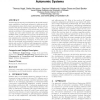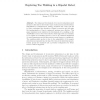131 search results - page 12 / 27 » Designing an Architecture for Adjustably Autonomous Robot Te... |
IROS
2006
IEEE
14 years 1 months ago
2006
IEEE
— This paper introduces the Extensible Agent Behavior Specification Language (XABSL) as a pragmatic tool for engineering the behavior of autonomous agents in complex and dynamic...
AAAI
2006
13 years 8 months ago
2006
The Robot Intelligence Kernel (RIK) is a portable, reconfigurable suite of perceptual, behavioral, and cognitive capabilities that can be used across many different platforms, env...
FM
1999
Springer
13 years 11 months ago
1999
Springer
Abstract. The design of controllers for hybridsystems
i.e. mixeddiscretecontinuous systems
in a systematic manner remains a challenging task. In this case study, we apply formal m...
ICAC
2009
IEEE
14 years 2 months ago
2009
IEEE
Architectural monitoring and adaptation allows self-management capabilities of autonomic systems to realize more powerful adaptation steps, which observe and adjust not only param...
AMS
2007
Springer
14 years 1 months ago
2007
Springer
The design and development of locomotory subsystems such as legs is a key issue in the broader topic of autonomous mobile systems. Simplification of substructures, sensing, actuat...



